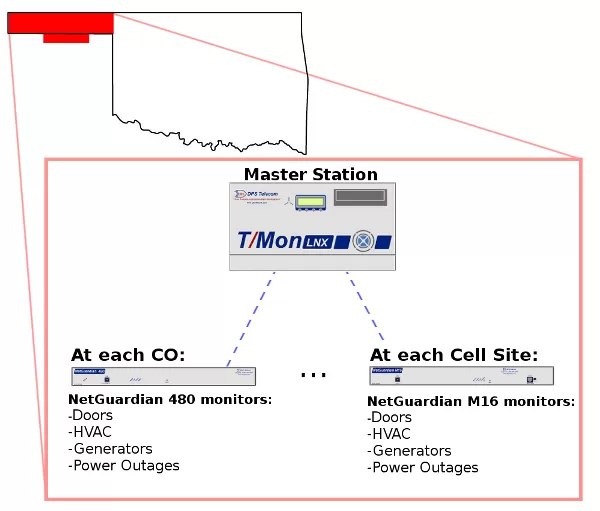Download our free Monitoring Fundamentals Tutorial.
An introduction to Monitoring Fundamentals strictly from the perspective of telecom network alarm management.
1-800-693-0351
Have a specific question? Ask our team of expert engineers and get a specific answer!
Sign up for the next DPS Factory Training!

Whether you're new to our equipment or you've used it for years, DPS factory training is the best way to get more from your monitoring.
Reserve Your Seat TodayFounded in 1954, Panhandle Telephone Cooperative, Inc. (PTCI) provides telephone, broadband, and 4G LTE wireless service across the three counties of the Oklahoma Panhandle. They're currently building out fiber-to-the-home (FTTH) to all of their exchanges.
"We cover the three counties of the Oklahoma Panhandle. It's almost 200 miles east-to-west," says Jason Kueffler, Broadband Network Technician at PTCI. "The panhandle is about 36 miles from top to bottom, but we also have some stuff in Texas. So it's a pretty good area."
With over 7,200 square miles of territory to cover, PTCI has a lot of sites and equipment. And, like most companies, they need to work efficiently with the resources they have.
"We have a bunch of COs, lots of cell sites, and lots of remotes," Kueffler continues. "We have one CO tech at the west end, east end, mid-central, and south, plus about five of us in the main office."
PTCI monitors doors, HVAC, generators, power outages, and other critical events to protect its telecom services in the Oklahoma Panhandle and portions of Texas. The monitoring system is built on NetGuardian RTUs and a T/Mon master station.

Following an industry best practice, PTCI has selected different RTUs to handle different types of sites. This avoids either running out of capacity or paying too much for an "overkill" solution.
"We use the NetGuardian 480 at our COs and then NetGuardian M16s at our cell sites," explains Ed Reust, Mobile Telephone Radio Technician. "And then we have a NetGuardian 832A G4 in our Genband C15."
To collect all of the data from each remote NetGuardian, PTCI uses a T/Mon master station. "We just upgraded to the T/Mon LNX," Reust says.
That upgrade was driven by planned future enhancements to monitoring at PTCI.
 |  |  |
| Jason Kueffler Broadband Network Technician | Ed Reust Mobile Telephone Radio Technician | Rahlon Burson Networking & Switching Services Technician |
According to Rahlon Burson, Networking & Switching Services Technician, "we upgraded to the LNX because we're going to add SNMP." Although T/Mon has long supported SNMP protocol, the PTCI team was looking forward to using the web interface and built-in device modules on the new LNX to configure SNMP devices quickly.
"The system lets us know instantly when there's a problem with some equipment," Kueffler says. "Especially power outages, door opens, air conditioner fails at COs, and generators running. If it's something that's unexpected, we can get somebody there to fix it. In some cases, if it's a power outage, we'll make a note of it and give it 15 or 20 minutes to let the power company restore service. Typically, power outages are just momentary blips. Otherwise, we'll call it in and report it."
Detecting failures immediately means that PTCI can deliver more reliable service to its customers at a lower cost. But reducing unpleasant surprises has personal benefits for the team as well.
"Without our monitoring, you'd have the five of us scrambling nonstop, which means we'd have less time at home." Reust explains. "We wouldn't know exactly what the problem is and be able to manage our manpower. As spread out as we are, as far as cell sites especially, that just wouldn't work."
As part of their upcoming T/Mon upgrade, Kueffler, Reust, and Burson visited Fresno headquarters for 4 days of factory training. The course covered both NetGuardian RTUs and the new T/Mon LNX web interface.
"Training was great," Kueffler says. "It kind of balances out stuff I've already been exposed to while working with the previous DPS T/Mon system."
"It was good getting exposed to making some changes in our existing T/Mon," Kueffler continues. "When we change on-call, and the person who normally does it is out of the office, we need to change the T/Mon notification schedule. It's just some simple stuff, but when you navigate into it after coming to class, now you'll understand it."
Before PTCI switched to NetGuardian RTUs, they had been using older DPS remotes called KDAs. That switch was driven not by RTU failure but rather a changing world. Any piece of communications equipment will eventually be incompatible with technology that didn't exist before.
"Probably the only reason that we replaced the KDAs was that we needed to incorporate newer equipment into the monitoring process," Burson says.
Having found reliable monitoring equipment, PTCI decided to stick with the same manufacturer for the next generation of technology.
Reust says, "The reason why we went back with DPS was because the KDAs were so reliable."
At DPS, we receive many urgent quote requests after an earlier "Do Nothing" decision comes back to bite you. You have no reason not to be proactive (and maybe you'll manage to impress your boss).
Call us. Chat with an expert for 10 minutes. We'll email you a detailed quote with a custom application drawing. We'll even include a summary of business benefits you can use to justify your project budget.
Call 1-800-693-0351 now for your quote
(or send us a quick online message instead)
Other Helpful Links
Essential Real-Time Monitoring Features For Your Network
In Their Own Words